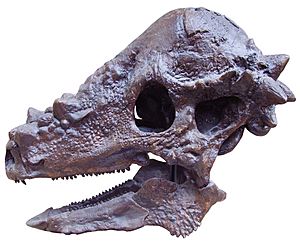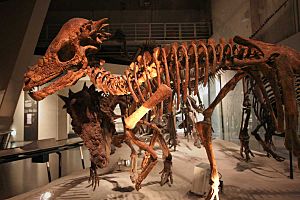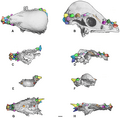Pachycephalosaur facts for kids
Quick facts for kids PachycephalosaursTemporal range: Upper Cretaceous
90 – 66 mya |
|
|---|---|
 |
|
| Skull of Pachycephalosaurus at the Oxford University Museum of Natural History | |
| Scientific classification | |
| Kingdom: | |
| Class: | |
| Subclass: | |
| Superorder: | |
| Order: | |
| Infraorder: |
Pachycephalosauria
|
| Family: |
Pachycephalosauridae
|
| Type species | |
| Pachycephalosaurus wyomingensis |
|

The Pachycephalosaurs were a group of plant-eating dinosaurs. They lived during the Upper Cretaceous period, about 90 to 66 million years ago. These dinosaurs are famous for their incredibly thick, bony skulls. Scientists believe they used these strong heads for protection and possibly for fighting over mates.
What Made Their Skulls Special?
Pachycephalosaurs belonged to a larger group of dinosaurs called ornithopods. Their most unique feature was their skull. Some species had a skull roof shaped like a dome, which could be several inches thick. Other species had flatter or wedge-shaped heads.
Scientists once thought flat-headed pachycephalosaurs were different species. However, some now believe they might have been younger versions of the dome-headed adults. The domes were often surrounded by small bumps called nodes or even spikes.
Did Pachycephalosaurs Head-Butt?
There is strong evidence that pachycephalosaurs used their thick skulls for head-butting. Researchers studied 100 pachycephalosaur skulls. They found that 20 of them showed signs of healed injuries. These injuries were consistent with fighting behavior.
The damage included small holes where the bone had become infected from wounds on the skin. This suggests that these dinosaurs might have used their heads for both showing off and defending themselves. Many modern animals, like bighorn sheep, use their heads in similar ways.
Images for kids
-
Pachycephalosaurid tooth. These teeth are similar to those of many other ornithischian dinosaurs.
-
Possible examples of pachycephalosaur combat behavior, showing different species: Pachycephalosaurus (A), Prenocephale (B), Stygimoloch (C).
-
A drawing of Homalocephale in its ancient environment.
See also
 In Spanish: Pachycephalosauria para niños
In Spanish: Pachycephalosauria para niños







